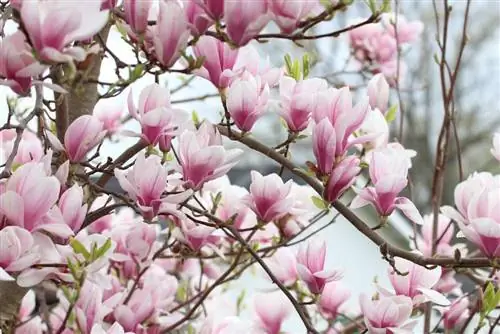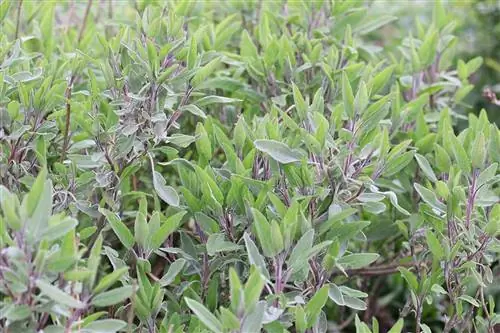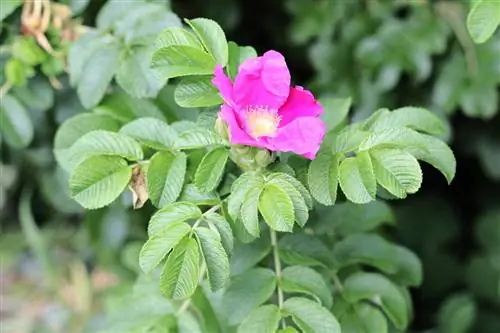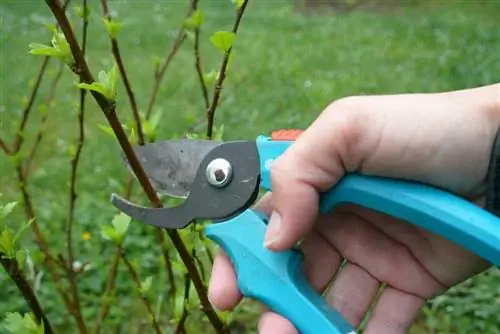- Author admin [email protected].
- Public 2023-12-17 03:39.
- Last modified 2025-01-24 12:45.
Tulip magnolias, one of the most beautiful varieties among the many different types of magnolias, were first mentioned around 1820 near Paris. The magnolia genus, however, is much older and dates back 100 million years, as it is probably the ancestor of all of today's flowering plants. Magnolia soulangiana is so popular in local gardens because it develops its beautiful, large flowers early in the year and is therefore considered a harbinger of spring.
Location
The tulip magnolia would like to be cultivated as a solitaire. As an older tree, it requires a lot of space. The crown here can be three to five meters wide on all sides if left alone. A location on a large meadow or in a garden bed with low plants is ideal. It is also a real eye-catcher in a front garden if it is large enough and the tree's crown does not hit house walls or dividing walls. In addition, the ideal location should have the following properties:
- sunny and bright
- warm
- protected from east wind
- A house wall or wall nearby can protect
Substrate & Soil
The tulip magnolia certainly places demands on the soil in which it is planted. This should therefore have the following features:
- humus-rich and sour
- lime-free
- moist but still water permeable
- A garden soil mixed with clay, peat and compost is ideal
- special rhododendron soil is also recommended
Watering & Fertilizing
The tulip magnolia always likes it slightly moist, but waterlogging should be avoided at all costs. Normal rainfall is usually sufficient throughout the year; it only needs to be watered during very hot and dry periods in summer. The soil should not dry out. Even in winter, watering must be carried out on frost-free days during longer dry periods. The tulip magnolia usually does not need fertilizer if the soil conditions are right. If this is not the case, you can also use special fertilizer for rhododendrons.
Tip:
Since the tulip magnolia prefers acidic and lime-free soil, this should be taken into account when watering. Therefore, use collected rainwater to water the magnolia tree. For this purpose, rain barrels can be placed in the garden or under the roof drain to collect the water.
Plants
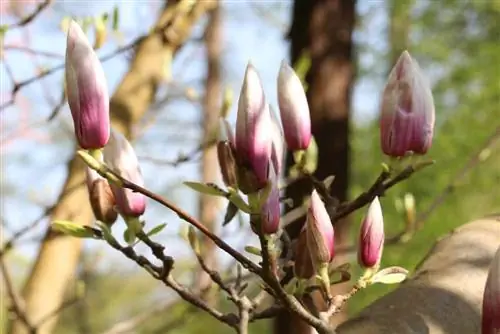
Magnolia soulangiana can be planted from spring to autumn. Care should be taken to ensure that there is enough time left from the planting date until the first frost, so that the tree is not at risk from frost while it is still growing. When purchased from a garden center, the trees are delivered as balled or container plants. Ball plants should be planted in spring, whereas container plants can be cultivated in their location until autumn. When planting, you should proceed as follows:
- The tulip magnolia is a shallow rooter
- Dig a hole about 50-60 cm
- Create drainage to prevent waterlogging
- Stones or shards of pottery on the bottom of the planting hole
- Insert Magnolia soulangiana in the middle
- fill in prepared soil and press lightly
- possibly use a rod to stabilize the trunk
- Tie up the trunk
- water well
Tip:
When a new tulip magnolia is introduced into the garden, it will not bloom for the first few years. The hobby gardener has to be patient for a few years, but since this is normal, there is no reason to worry.
Cutting
Like all magnolias, the tulip magnolia does not tolerate pruning very well. Therefore, it should only be cut if absolutely necessary. The ideal time is spring after flowering. But a radical cut should be avoided. Pruning is usually only done every four to five years. In addition, there is the small pruning in which dead and diseased branches are removed throughout the year. A radical cut should therefore only be carried out if the magnolia is suffering from fungus or storm damage. Then all damaged and infected branches must be removed. As an exception, this radical cut can also be done in the fall, as it cannot cause any more damage than has already occurred. But this should remain the only exception. Otherwise, ideally a spring cut should be done as follows:
- only use sharp and disinfected tools
- otherwise bacteria and fungi can invade
- Always remove the branch very close and straight to the trunk
- If small bumps remain, unsightly shoots will form
- these then have to be constantly removed again
- Just thin out the crown
- only remove branches growing inwards or crosswise
- cover larger interfaces with plant wax
Tip:
If the tulip magnolia is cut later than June, it will no longer be able to recover properly until winter, and the flowering will usually fail in the following year.
Sowing
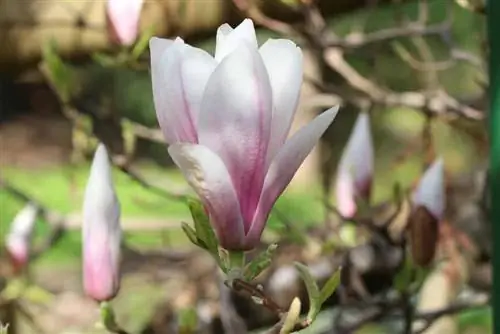
Magnolias are frost or cold germinators. This means that the seed needs cold before it can be used. Therefore, before it goes into the ground to germinate, it should be placed in the freezer for three to four months. To do this, however, the container should be closed so well that no moisture can penetrate. In a very cold winter, the seeds can also be left outside on the terrace or balcony. After the winter, sowing can then take place:
- pods form after flowering
- when the seeds are ripe, these pods burst open
- Put seeds in lukewarm water for a few days
- then remove the pulp and place the seeds in a can with sand
- then store in the refrigerator or freezer
- the ideal time for sowing is spring
- the earth should already be slightly warm
Nevertheless, the seeds do not go directly into the ground, but are placed in small pots in growing soil. These pots, in turn, are buried in the garden soil and always kept moist. On cool days, protect the pots with a transparent film. However, if frosty nights come again, the pots with the seedlings should be dug up again and brought inside. The germination time can take a very long time, so you should be patient. The frost-sensitive young plants should also remain in their growing pot for the first year and spend the first winter inside. They can then be planted in the garden next spring.
Propagate with cuttings
Hobby gardeners who have already cultivated one or more tulip magnolias can easily propagate them using cuttings. Therefore, when cutting, do not throw away the removed shoots, but use them as cuttings for a new tree. Otherwise, propagation by cuttings is carried out as follows:
- only use he althy shoots
- The tulip magnolia is an evergreen variety
- therefore cut the shoots in the months of August/September/beginning of October
- these should be semi-woody
- put in a sand-earth mixture
- place in a bright, frost-free location
- roots form, can be planted
- this is often the case next spring
Tip:
Sowing seeds and/or gaining new trees through propagation is always worthwhile with tulip magnolias. The decorative plants offered in selected specialist retailers are often very expensive. Therefore, it is worth the time it takes to grow the magnolias yourself.
Propagate by lowering
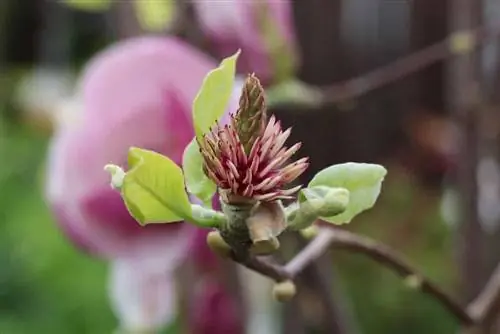
Propagation is very easy by lowering. To do this, one or more shoots that are suitable for lowering are selected in midsummer, July or August. Ideally, these are located near the ground, because this is where the shoots have to be pulled carefully. Here they are slightly bent, although a wound on the shoot should be avoided. With this bend the shoots come into the ground, the shoot tip looks out. The shoot remains on the mother plant until roots have formed and is only then cut off. This can take one to one and a half years, so you should be patient. As soon as the roots have formed and the shoot has been cut off, the resulting new plant can be planted in its final location.
Tip:
In order to anchor the shoot well underground in the ground, tent pegs can be used to hold the shoot in place. Alternatively, a curved iron pin, for example a thick and large nail, can be used. However, this must first be given an oval shape with an opening.
Propagate by mossing
It's even easier to propagate tulip magnolias than the other two methods with moss. For this purpose, the selected shoot also remains on the mother plant. To do this, proceed as follows:
- The shoot should be a maximum of one centimeter thick and young
- Cut lengthwise into the bark about 20 to 30 centimeters below the tip
- use a sharp and disinfected knife for this
- to open the gap and keep it open, open with a match
- then wrap tightly with moist moss
- wrap everything in a plastic bag with holes in it
- tie tightly
- Keep moss moist until roots develop
- then cut the shoot below the roots from the trunk
- planting
Tip:
Better than propagating the tulip magnolia with cuttings, you can do this by lowering it, or even better by removing moss. Because with cuttings, mold can quickly form, the shoots stuck in the ground will not sprout and will not take root.
Cultivated in a bucket
The tulip magnolia can also be cultivated in a pot. Since magnolias grow very slowly, they do not necessarily need to be repotted every year. If the trees are grown in containers, they must not be cut. Only dead branches are removed. When planting in a bucket, proceed as follows:
- create drainage on the planting hole
- The tulip magnolia does not tolerate any waterlogging
- to do this, place potsherds or stones on the drain hole
- place plant fleece over this to avoid clogging with soil
- fill in half the prepared rhododendron soil
- Insert the plant and press the soil down well
- then water enough
- After half an hour, remove the excess water from the plate
- The same procedure is followed when repotting
Wintering
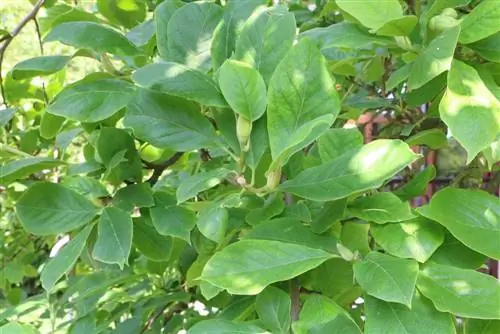
Like all types of magnolia, Magnolia soulangiana is also only partially hardy because it does not tolerate a long period of frost well if left unprotected. The roots in particular should be protected from frost. Unfortunately, if frost hits an existing flower, this is not good for the decorative flowers either and they turn brown. Unfortunately, with very large and balancing trees this usually has to be accepted. However, to protect the roots, you should proceed as follows:
- Place mulch, leaves or jute mats on the ground around the trunk
- this prevents frost from hitting the ground
- The trunk can also be wrapped with jute mats or plant fleece
Magnolias grown in pots should also be protected. If possible, they can be kept dry and slightly warm. An unheated winter garden would be ideal for this. But other bright rooms are also possible. However, a dark basement is not suitable. If there is no space available, the tulip magnolia can also be left outside in the pot. To do this, proceed as follows:
- Protect the pot all around with plant fleece or jute mats
- add mulch to the soil
- place the bucket on a polystyrene plate or wood
- If there is severe frost and an unprotected place, wrap the rest of the plant with fleece
- when the first flowers appear and there is a risk of frost, use plant fleece
- work carefully so that the flowers are not damaged
Care errors, diseases & pests
If the soil is too calcareous, the tulip magnolia can suffer from chlorosis, which is shown by yellowish leaves. If this is the case, a remedy should be taken and the floor should be descaled. It may also be due to the water supply if tap water is used here. Unfortunately, there is no longer any help for the flowers that have already formed during the flowering year. But next year the magnolia tree will once again bear its uncolored flowers.
Conclusion
If the tulip magnolia is given the right care, it will reward you with beautiful, sprawling growth and decorative blooms in spring. Sometimes it even develops a second flower in the summer months. The decorative tree often does not require much care, as pruning is usually not necessary, just the chosen location should be right. In winter, the tree should also be slightly protected from frost. Regular watering during long dry periods is also necessary.

